Earth’s Climates. Global Climate Zones
Chapter Summary. This chapter gives an overview of the various climates found on Earth at the macroscale, mesoscale, and microscale. Macroclimate is the large-scale climate over 2000 km or more resulting from geographic variation in net radiation, the resultant transport of heat by the atmosphere and oceans, and high and low surface pressure belts. Temperature and precipitation distinguish various macroclimate zones. One classification scheme is that of Koppen, which illustrates the major climate zones. Mesoclimates and microclimates are regional and local climates, respectively.
Microclimates are climatic features typically smaller than 2 km. A forest has a different microclimate than an adjacent clearing. Mesoscale is between microscale and macroscale, covering atmospheric processes at scales of 2-2000 km. Regional (mesoscale) climates are illustrated in terms of the effect of topography on solar radiation, temperature, and precipitation in mountains. Lakes and oceans also influence regional climate, with generally mild temperatures and reduced temperature variability compared with inland climates. Differential heating between land and ocean results in a local circulation known as a sea breeze.
Global Climate Zones. Although no two places experience exactly the same climate, several generalized climate zones can be recognized. Figure 2.1 illustrates one such climate classification - the Koppen classification as modified by Trewartha (Finch et al. 1957; Trewartha 1968). This scheme utilizes five major climate zones based on temperature and precipitation.
1. Humid tropical climate: warm year-round; coldest month 18°C or warmer.
2. Dry climate: deficient precipitation throughout the year; potential evapotranspiration exceeds precipitation.
3. Moist subtropical mid-latitude climate: warm to hot summers with mild winters; coldest month above -3°C but below 18°C; warmest month above 10°C.
4. Moist continental climate: warm summers and cold winters; coldest month below -3°C; warmest month above 10°C.
5. Polar climate: extremely cold winters and cold summers; warmest month below 10°C.
Each of these climate zones has subzones defined by temperature and precipitation (Table 6.1).

Humid tropical climates occur where temperatures are warm throughout the year. A tropical rainforest climate occurs where rainfall is abundant throughout the year; a tropical savanna climate develops where there is a pronounced dry season. In both climate zones, seasonal variation in air temperature is minimal (less than a few degrees). In the tropical rainforest zone, rainfall is abundant throughout the year but may vary seasonally with the position of the intertropical convergence zone (Figure 6.1).
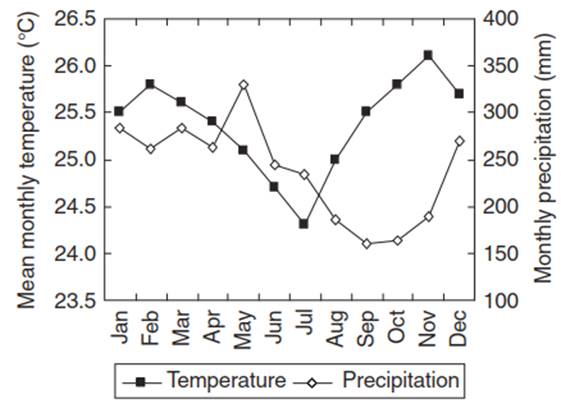
Fig. 6.1. Tropical rainforest climate, Uaupes, Brazil. Data from Schwerdtfeger (1976, p. 270)
Tropical rainforest climates occur in hot, wet equatorial regions of South America, Africa, southeast Asia, and Indonesia. The tropical savanna climate occurs in tropical regions that are warm year-round but have a pronounced dry season. In the example shown in Figure 6.2, the rainy season is from April to October. Little rainfall occurs in December-February, when a subtropical high pressure influences the region. The double peak in summer precipitation reflects the seasonal migration of the inter- tropical convergence zone across the equator.

Fig. 6.2. Tropical savanna climate, Kintampo, Ghana. Data from Griffi ths (1972, p. 248)
Temperatures are warmer during the dry season than in the rainy season when clouds cool the surface. Tropical savanna climates occur in Central America, to the north and south of the Amazon Basin in South America, to the north and south of the Congo Basin in Africa, east Africa, parts of India and Southeast Asia, and northern Australia.
Dry climates, which occur where rainfall is sparse throughout the year, are divided into semiarid and arid climates based on moisture deficiency. The semiarid climate develops in temperate regions, most prominently in the Great Plains of the United States, the steppes of Central Asia, and parts of southern South America, southern Africa, and Australia. Figure 6.3 shows an example climate. In this particular location, most precipitation falls in April and May. Temperatures are hot during June to August when the clear sky and intense solar radiation heat the surface. The arid climate of deserts is not only dry, but also hot as solar radiation readily penetrates the clear, dry skies (Figure 6.4).

Fig. 6.3. Semiarid climate, Denver, Colorado, USA. Data from Bryson and hare (1974, p. 277)
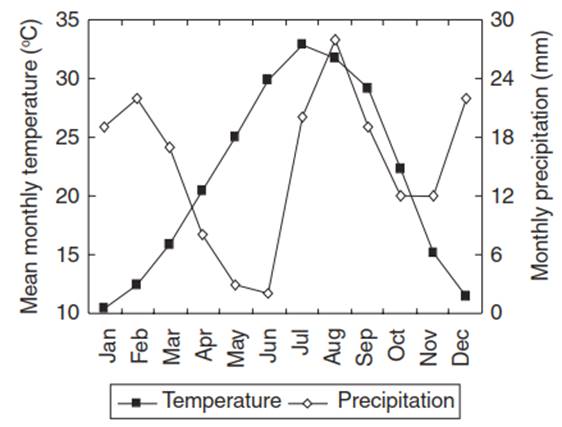
Fig. 6.4. Arid climate, Phoenix, arizona, USA. Data from Bryson and hare (1974, p. 268)
Desert climates occur on the eastern flanks of the subtropical high pressures near latitudes 30° N and 30° S, chiefly in southwestern United States, North Africa, southern South America, South Africa, and western Australia. They also establish in continental areas of the middle latitudes that are far removed from sources of atmospheric moisture such as central Asia, central Australia, and the Great Basin of western United States.
Moist subtropical middle latitude climates occur in regions with distinct summer and winter seasons, where summers are warm to hot and winters are mild. They are divided into Mediterranean, humid subtropical, and marine zones. Mediterranean climates develop where a summer dry season is pronounced, such as in southern California and along coastal areas of the Mediterranean Sea. These climates have mild, moist winters and hot, dry summers (Figure 6.5). Humid subtropical climates form in southeastern United States, eastern China, Japan, and along the southeastern coasts of South America, Africa, and Australia. These climates occur on the western edge of subtropical high pressure areas, which drives warm, moist tropical air towards the middle latitudes, and consequently have hot, humid summers (Figure 6.6).

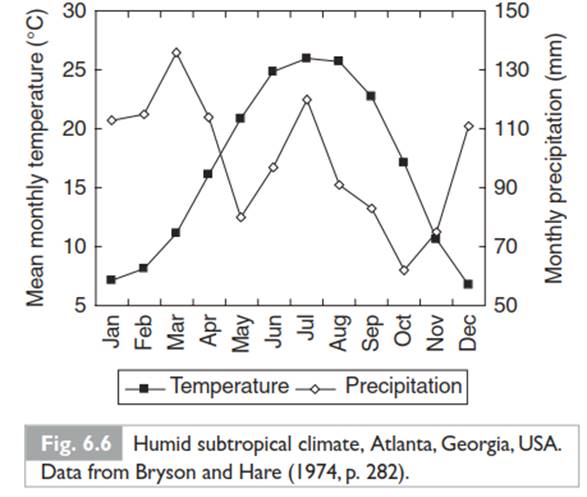
Winters are mild and precipitation is abundant throughout the year. Moderate to pronounced seasonality is a dominant feature of climate. Marine climates occur in the Pacific Northwest region of the United States, western Europe, and western South America in middle latitudes where oceans moderate climate. Marine climates have mild winters, with temperatures rarely below freezing, cool summers, and abundant precipitation year-round (Figure 6.7).
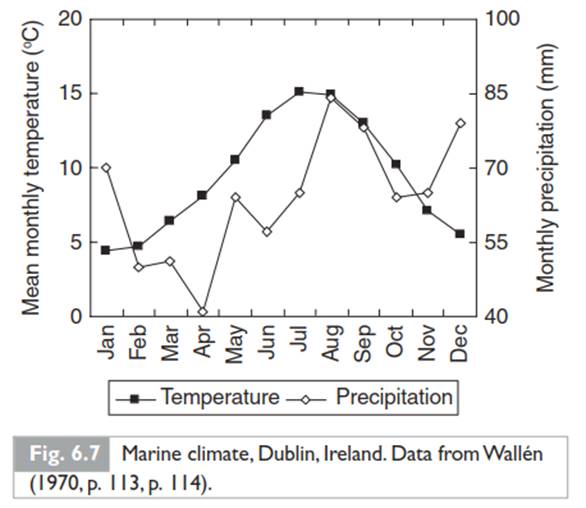
Moist continental climates occur in the northern regions of North America, Europe, and Asia. Large seasonal variation in temperature, with moderate to cool summers and cold winters, characterizes the climate. The humid continental subzone is divided into warm summer (Figure 6.8) and cool summer (Figure 6.9) regions based on whether the warmest month is above or below 22°C. Farther north, in Alaska, northern Canada, northern Europe, and northern Russia, where the winters are bitterly cold and the summers are cool and short, the climate is subarctic (Figure 6.10). Precipitation is generally light.
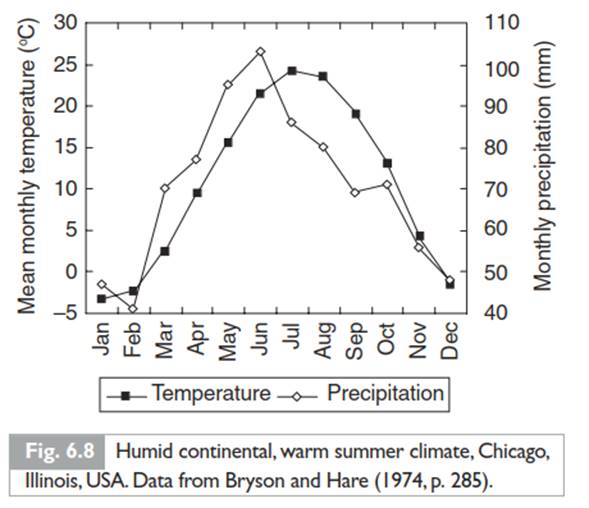
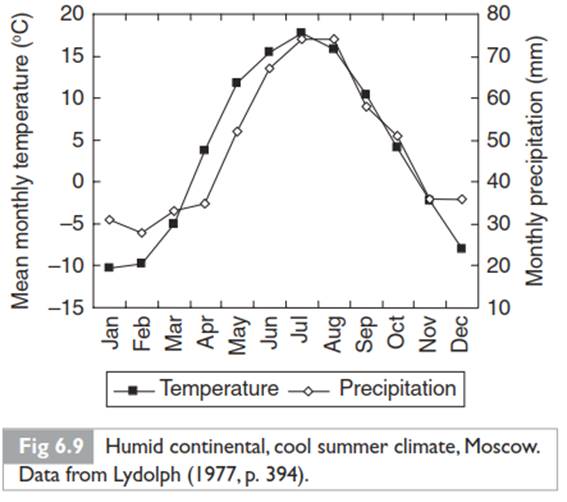
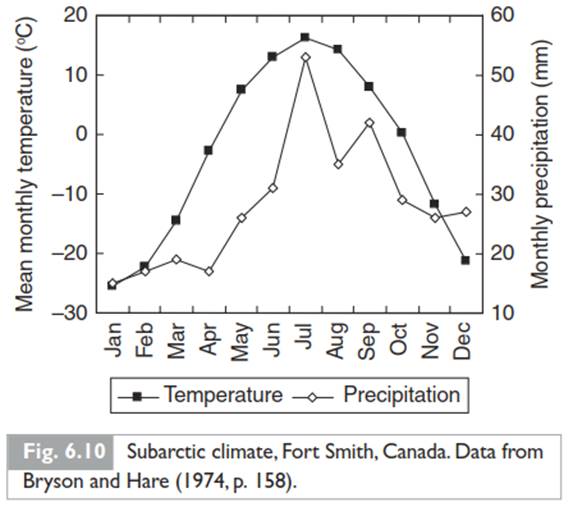
Polar climates develop in high latitudes or mountain tops where the warmest month is below 10°C. Tundra climates arise where plants can still survive in the short summers and long, cold winters (Figure 6.11). In the extreme cold of Greenland and Antarctica, little vegetation grows and permanent glaciers cover the land (Figure 6.12).
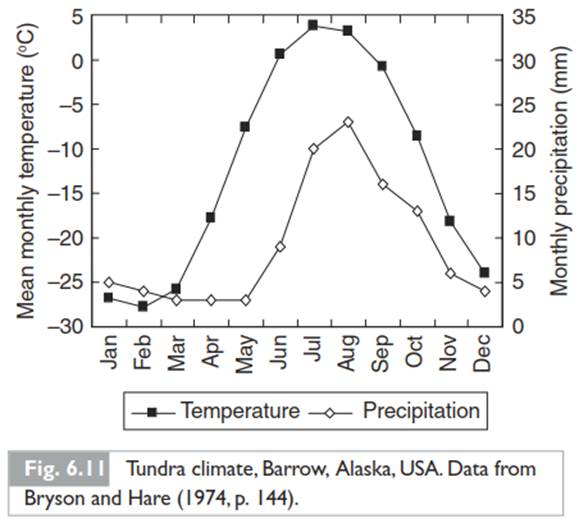
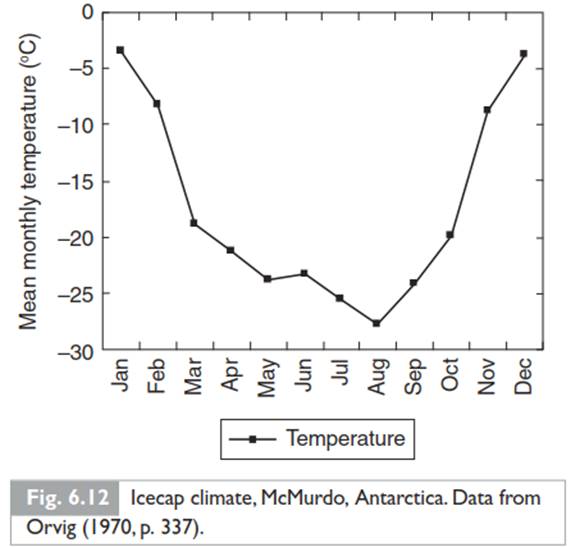
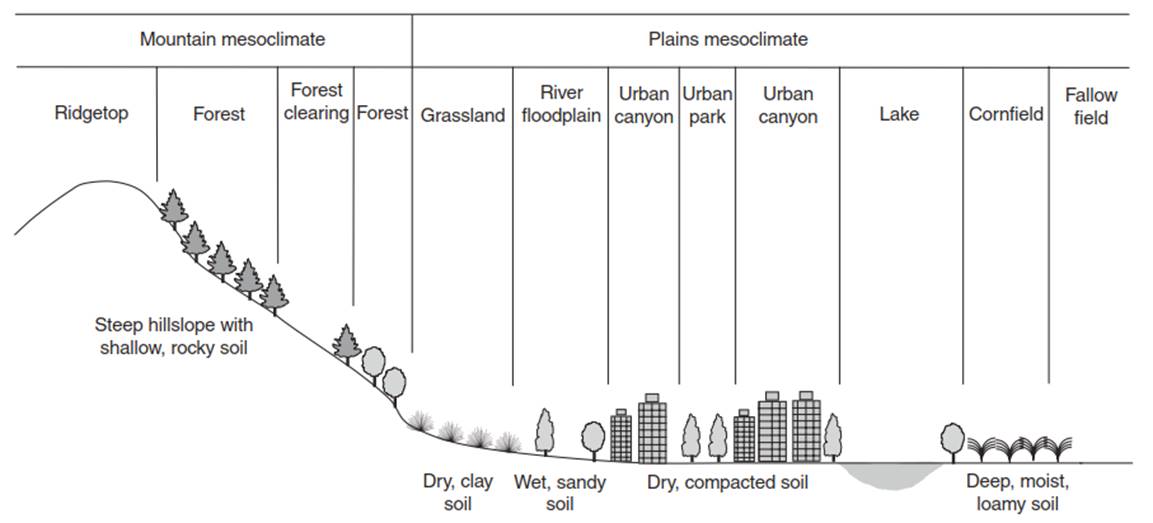
Fig. 6.13. Variation in topography, soils, and land cover across a hypothetical landscape that creates mountain and plains mesoclimates and numerous microclimates within a humid continental macroclimate
At the local and regional scale, climate can deviate markedly from that expected according to macroscale climate classifications. The landscape is a mosaic of patches created by spatial variation in topography, soils, and land cover (Figure 6.13). By altering the cycling of energy and water between land and atmosphere, landscape heterogeneity can create unique microclimates and mesoclimates that differ from the prevailing macroclimate. For example, mountains, with variation in elevation and slope of terrain, have a different mesoclimate from plains. Within mountains, valleys have a different microclimate from ridgetops. Forests have a different microclimate from open rangeland.
Date added: 2025-05-15; views: 449;
